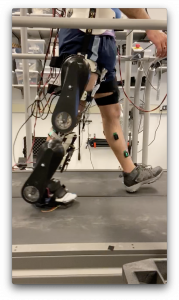Presented By: Michigan Robotics
Optimal Task-Invariant Energetic Control for Powered Exoskeletons
PhD Defense, Jianping Lin

Powered exoskeletons have been developed to serve as rehabilitation devices and provide gait assistance to human users. It enhances a healthy person's abilities and supports a physically challenged person's daily life by providing powered hip, knee, and/or ankle motions with different control designs. State-of-art powered exoskeletons use trajectory-based, kinematic control methods for specific tasks. This type of control is appropriate for paraplegia, where the exoskeleton provides complete assistance. However, it overly constrains the volitional motion of people with remnant voluntary ability, e.g., stroke patients. In contrast, trajectory-free control methods are now being developed to provide task-invariant partial assistance for practicing/relearning leg motions or performing a continuum of activities in varying environments. Robotics systems like powered exoskeletons can be represented in the format of the Euler-Lagrange equation or the equivalent class, the port-controlled Hamiltonian equations. We use energy shaping methods for task-invariance by altering the human-exoskeleton system's dynamic characteristics via the Euler-Lagrange equations or the more general port-controlled Hamiltonian equations. Under satisfaction of the matching conditions, which is a set of nonlinear partial differential equations (PDEs), the open-loop system's mass/inertia matrix and gravitational vector can be mapped to the desired closed-loop system dynamics.
Energy shaping has broad applicability but has been limited in part by its computational and analytical complexity. Changes to the system dynamics must follow the solution to the matching conditions, while finding a solution to the matching conditions itself is challenging. The corresponding controller for kinetic energy shaping requires complicated calculations of the mass/inertia matrix inverse, where the computational cost for implementation increases tremendously. Potential energy shaping avoids the matrix inversion by altering only the potential energy but prevents shaping on the inertia terms. Such challenges require a new total energy shaping (TES) framework that provides flexible shaping structures with more freedom to change closed-loop dynamics over the potential energy shaping method. The corresponding control law with shaped structure also requires efforts to optimally achieve the powered exoskeletons' target control strategy for different locomotor tasks. Therefore, the specific aims of this project are: 1) construct a TES framework for powered exoskeletons with flexible shaping structure, 2) apply the framework to powered exoskeletons for optimal assistance across varying locomotor tasks, and 3) perform experiments on multiple human subjects to demonstrate the possible clinical benefits of optimal TES framework with powered lower-limb exoskeletons.
This work is significant to the viability and performance of energy shaping methods to nonlinear systems by simplifying the matching conditions and providing flexibility in inertia forces/torques compensation. In powered exoskeletons, inertia compensation does not require modifying the mass/inertia matrix with high dimensions, and the corresponding controllers are efficient for experimental implementation. The powered exoskeletons' target control strategy uses normative torque patterns to provide assistance or augment performance. We formulate an optimization problem to design the controller and produce joint torques that fit normative biological joint torques and offload musculature for walking on multiple tasks, including stairs. We perform experiments with multiple able-bodied human subjects wearing a knee-ankle exoskeleton to demonstrate reduced activation in certain lower-limb muscles on multiple tasks.
Energy shaping has broad applicability but has been limited in part by its computational and analytical complexity. Changes to the system dynamics must follow the solution to the matching conditions, while finding a solution to the matching conditions itself is challenging. The corresponding controller for kinetic energy shaping requires complicated calculations of the mass/inertia matrix inverse, where the computational cost for implementation increases tremendously. Potential energy shaping avoids the matrix inversion by altering only the potential energy but prevents shaping on the inertia terms. Such challenges require a new total energy shaping (TES) framework that provides flexible shaping structures with more freedom to change closed-loop dynamics over the potential energy shaping method. The corresponding control law with shaped structure also requires efforts to optimally achieve the powered exoskeletons' target control strategy for different locomotor tasks. Therefore, the specific aims of this project are: 1) construct a TES framework for powered exoskeletons with flexible shaping structure, 2) apply the framework to powered exoskeletons for optimal assistance across varying locomotor tasks, and 3) perform experiments on multiple human subjects to demonstrate the possible clinical benefits of optimal TES framework with powered lower-limb exoskeletons.
This work is significant to the viability and performance of energy shaping methods to nonlinear systems by simplifying the matching conditions and providing flexibility in inertia forces/torques compensation. In powered exoskeletons, inertia compensation does not require modifying the mass/inertia matrix with high dimensions, and the corresponding controllers are efficient for experimental implementation. The powered exoskeletons' target control strategy uses normative torque patterns to provide assistance or augment performance. We formulate an optimization problem to design the controller and produce joint torques that fit normative biological joint torques and offload musculature for walking on multiple tasks, including stairs. We perform experiments with multiple able-bodied human subjects wearing a knee-ankle exoskeleton to demonstrate reduced activation in certain lower-limb muscles on multiple tasks.